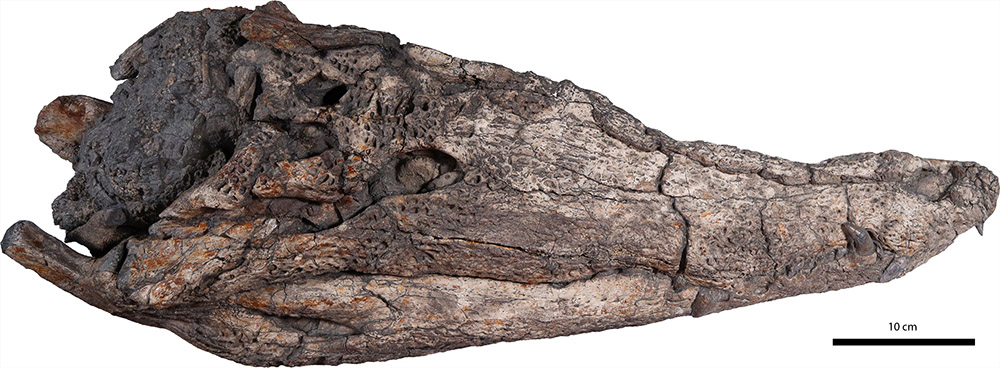Press Releases Archive
19.05.2022
Previously unknown crocodile species lived in Asia 39 million years ago
Maomingosuchus grew to four meters long - research team identifies fossils from Vietnam
Researchers from the Senckenberg Centre for Human Evolution and Palaeoenvironment at the University of Tübingen have identified fossils of a previously unknown crocodile species in Vietnam. The nearly four-meter-long, almost completely preserved skeleton from the Na Duong site is part of the group of long-snouted crocodiles from the gharial family. The fossil, which is between 35 and 39 million years old, provides new information about the spread of these crocodiles from their origins in North Africa and Western Europe to Southeast Asia. The study has been published in the Journal of Systematic Palaeontology.
Gharials have a long snout and specialize in catching fish. The representatives of this family living today are endangered: the false gharial (Tomistoma schlegelii) in the Malay Peninsula, Borneo, Sumatra and Java as well as the gharial (Gavialis gangeticus) in Nepal and India. The exact relationship between these present-day crocodile species has not yet been conclusively clarified, despite genetic studies.
Based on the many fossil finds of false gharial relatives from North Africa and Europe, palaeontologists believe that this crocodile species originated more than 50 million years ago in the western Tethys, a precursor to today's Mediterranean Sea. However, little is known about how, why and when exactly the species reached its current range in South Asia.
The newly-described species was named Maomingosuchus acutirostris (acutirostris is Latin for "the pointy-snouted one") and - along with known crocodile species from southern China and Thailand - is the oldest representative of the false gharial relatives in Asia. "The results indicated that the dispersal of these species to Asia was not a one-time event, but rather a complex scenario," said Tobias Massonne of the Senckenberg Centre for Human Evolution and Palaeoenvironment at the University of Tübingen. "The data suggest that relatives of the false gharial colonized Southeast Asia three times independently. The first-time colonization by the stem lineage of Maomingosuchus from North Africa and Western Europe to East Asia occurred during the Eocene era, more than 39 million years ago."
In 2019, the research team described a previously unknown alligator relative (Orientalosuchus naduongensis), approximately two meters long, from the same site. Both crocodiles, the short-snouted Orientalosuchus and the long-snouted Maomingosuchus, lived in a lake in what is now northern Vietnam. Close relatives of both species also lived at similar times in southern China and Thailand. "Despite the proximity of the three localities where Maomingosuchus and relatives of Orientalosuchus were found, it is striking that they are distinct species and that no species occurs in all three regions. We see this as evidence of the high diversity of crocodiles in Asia at that time," adds Professor Madelaine Böhme, who led the excavation campaign in Vietnam from 2009 to 2012.
Contact:
Tobias Massonne
University of Tübingen
Senckenberg Center for Human Evolution and Palaeoenvironment
Phone +49 7071 29-74710
tobias.massonne@uni-tuebingen.de
Professor Dr. Madelaine Böhme
University of Tübingen
Senckenberg Center for Human Evolution and Palaeoenvironment
Phone +49 7071 29-73191
m.boehme@ifg.uni-tuebingen.de
Contact for press:
Eberhard Karls Universität Tübingen
Public Relations Department
Dr. Karl Guido Rijkhoek
Director
Janna Eberhardt
Research Reporter
Telefon +49 7071 29-77853
Fax +49 7071 29-5566
janna.eberhardt@uni-tuebingen.de
All press releases by the University of Tübingen

